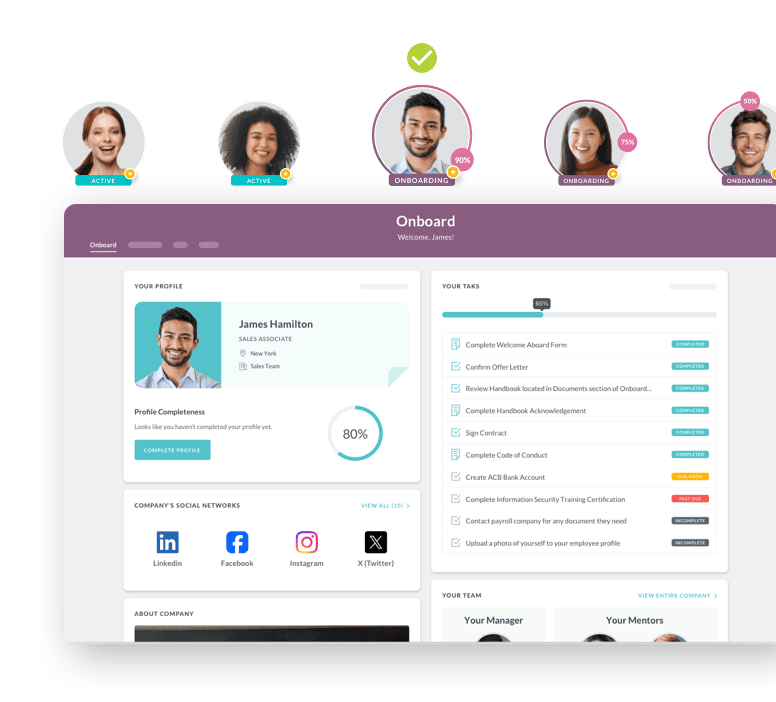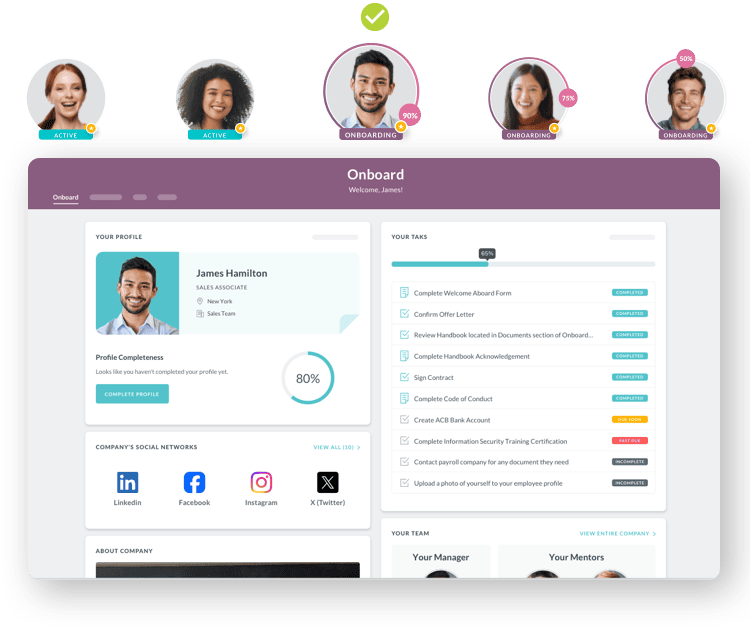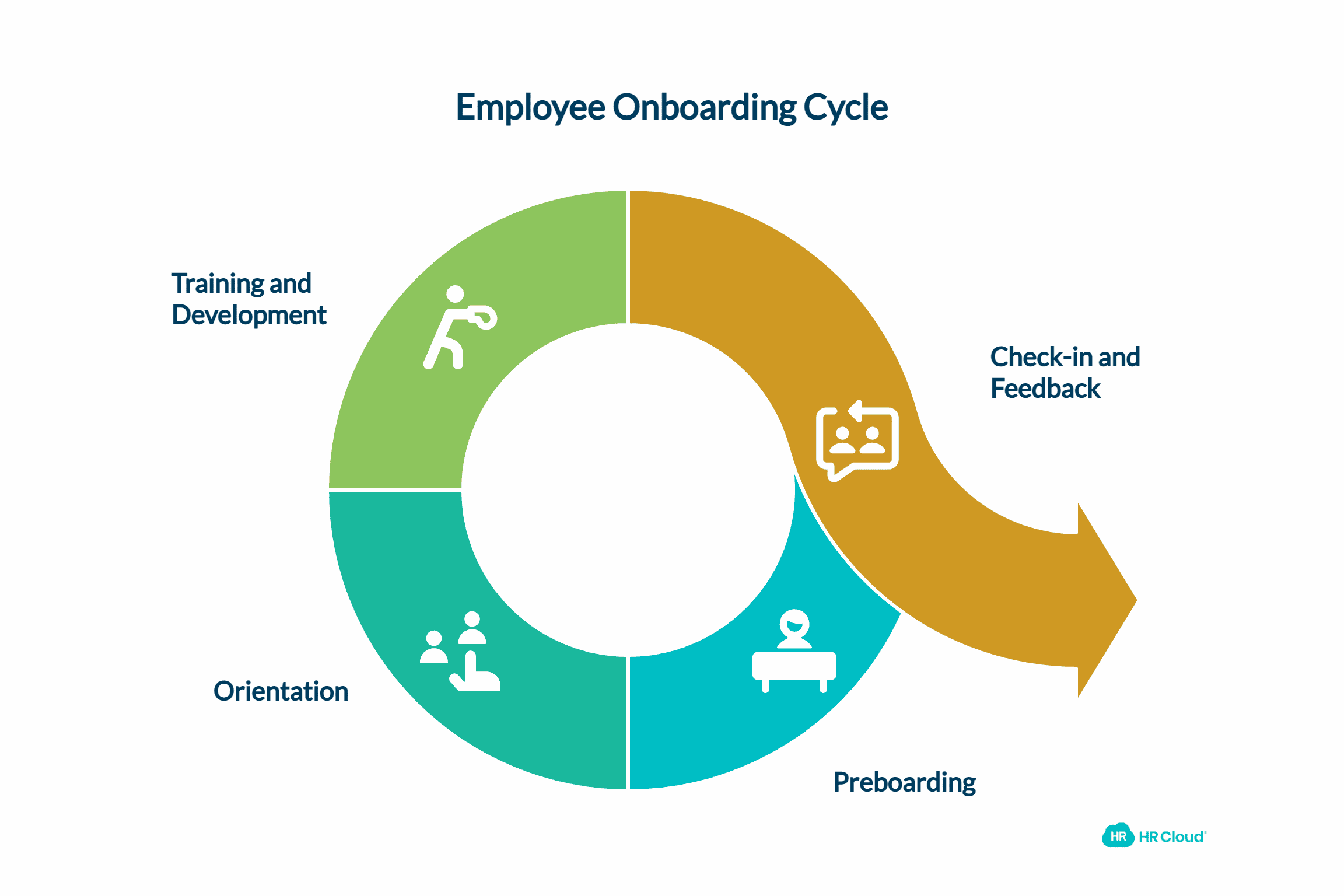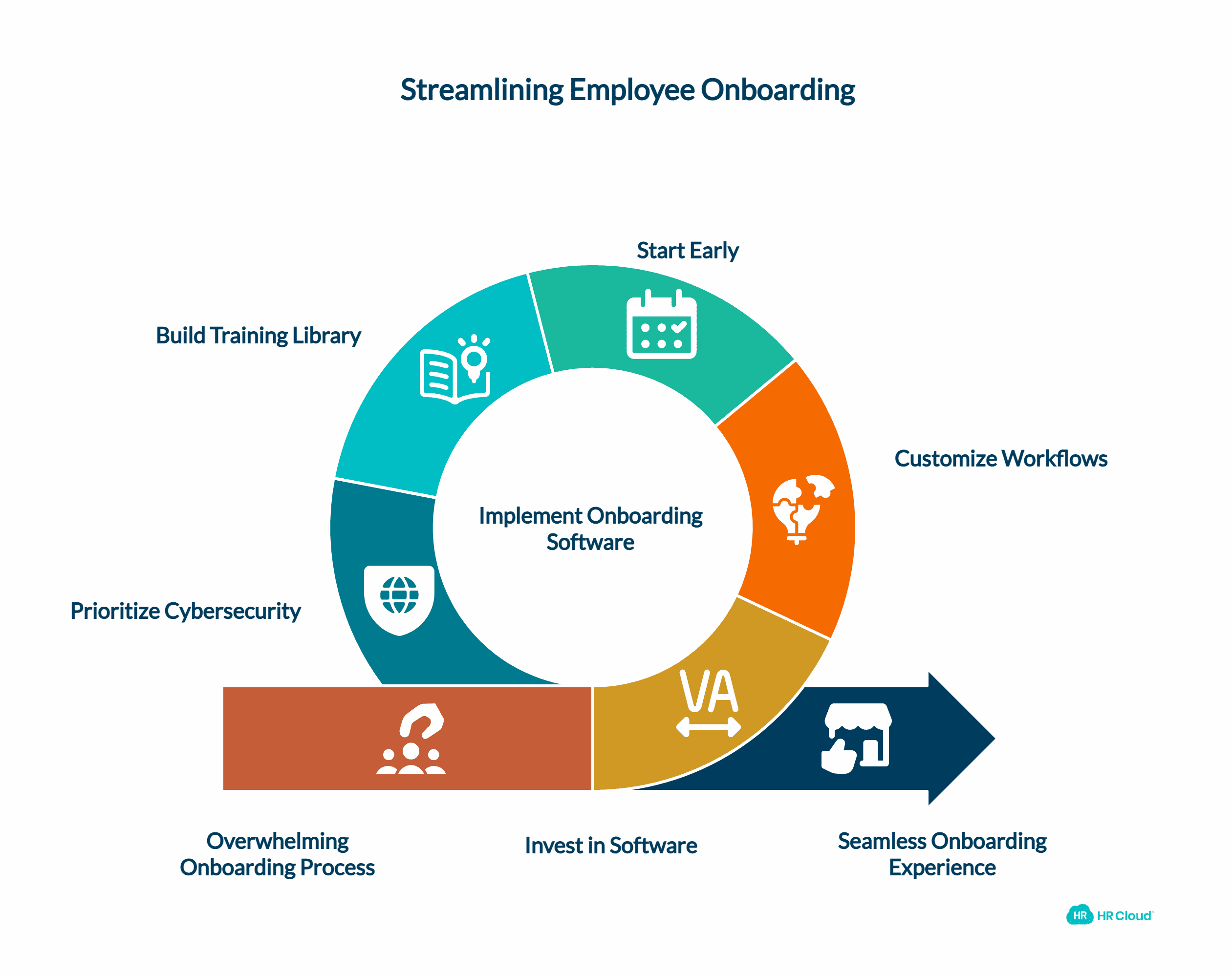

 Cut onboarding time
by 60%—here's the
Ultimate Checklist
that helped do it.
Cut onboarding time
by 60%—here's the
Ultimate Checklist
that helped do it.

Calling all HR teams. Are you tired of the same old onboarding process that seems to drag on forever? Are the small details falling through the cracks?
We won't blame you. Sometimes it feels like a complex math equation to keep track of everyone's start dates during peak hiring seasons.
Or maybe you're a new business owner unsure where to start with employee onboarding. Fear not. We've got you covered with this comprehensive onboarding guide.
New employee onboarding doesn't have to be a headache, and it certainly doesn't have to be boring. In fact, it can be an exciting opportunity to welcome your new hires to the team and set them up for success.
Sadly, most companies fall short in this regard, with 88% of employees agreeing that their company doesn't do a great job onboarding new employees.
So, grab your coffee (or juice, we won't judge), and let's explore some practical tips and tricks for making the employee onboarding process a breeze. Let's dive in.
What is Employee Onboarding?
First things first, let's get the basics out of the way and quickly provide an onboarding definition.
Employee onboarding is the process of integrating new hires into your company culture and providing them with everything they need to succeed. And the secret sauce to successfully onboarding a new employee? Making them feel welcome from day one. In other words, it's more than having them fill out a direct deposit form followed by an outdated PowerPoint presentation.
You should look at the employee onboarding process as having four stages:
-
Preboarding
-
New hire orientation
-
Onboarding training and development
-
Check-in and feedback
Each stage has unique goals and objectives — but all four are crucial for setting your new hires up for success.
Preboarding
As the name suggests, this stage occurs before the employee's first day and is the first step in the employee lifecycle. It includes tasks such as sending welcome emails, setting up their email, and sharing relevant company information.
For example, send a welcome email with a link to a video introducing them to the company culture or share a document that outlines the dress code and first day checklists.
Also, don't forget to confirm their start date and time. And if they are working in an office, help ease their first-day anxiety by offering parking solutions. In addition, you can share with the new hire their employee schedule so they know what to expect on their first day. You can even share with them the whole team schedule so they know the availability of their new team members if they were to need help on their first day.
Orientation
Similar to the first week of college, where freshmen familiarize themselves with the campus and meet new friends, there's a similar experience in the professional workplace.
The goal of new hire orientation is to introduce new hires to your company's culture, policies, and procedures. You might schedule an office tour and introduce them to their team members and managers.
During orientation, you should also review employee benefits and perks — like health insurance, retirement plans, or gym memberships. You can even offer unique benefits like health insurance for multiple pets.
Why? Recent surveys show that 62% of employees prioritize their pet's health. And unsurprisingly, 74% of pet owners consider pet insurance a must-have or nice-to-have benefit.
So reviewing these benefits during the first week of work helps set a positive tone for your employees right off the bat.
Training and Development
Typically, your first few days at work involve shadowing a co-worker or running through training documents or videos to get up to speed on the new skills required for the new role.
If the new hire is a salesperson, you might have them attend a training session on your sales process or observe your top-performing sales reps.
But onboarding training processes won't look the same for every employee. Tailoring your training and development programs to new joiners' specific roles and experience levels is crucial for an effective onboarding strategy.
Check-in and Feedback
Finally, it's important to check in now and again to make sure your new hires are happy, engaged, and have the support they need to succeed.
You might encourage managers to schedule a monthly one-on-one meeting with a new hire to discuss their progress and provide feedback. Or your HR team can send new hire surveys to gather feedback on the full onboarding process. In this case, make sure to validate email addresses for accuracy before sending out any important communication.
If the survey results show that engagement is lower than you hoped, take to the drawing board and brainstorm a few employee engagement strategies (e.g., recognition and rewards, work-life balance, professional development opportunities, etc.).
Keep the ball rolling and formally invest in an employee engagement program to reignite the spark in your employees and improve employee satisfaction once and for all.
Common Challenges of Employee Onboarding
While new employee onboarding is essential, it's not always easy. We've all faced numerous challenges during onboarding, including:
-
Paperwork overload
-
Disorganized training materials
-
Lack of communication with other departments
-
Poorly executed new hire orientation or training sessions
-
Slowdown or delay in the onboarding process
-
Inadequate support or resources for new hires
-
Difficulties with remote employee onboarding
And when these challenges bubble to the surface and employees take notice, it can cause new hires to feel overwhelmed or disengaged.
The result? Lower employee retention rates, reduced employee engagement, and lower productivity. And that's the worst-case scenario for all parties involved.
But don't fret. We'll dive into some practical tips and tricks for overcoming these challenges and making employee onboarding a success.


Best Practices for Employee Onboarding
Get ready to take notes because these tips will help create a seamless and engaging onboarding experience for your new hires.
1. Invest in Employee Onboarding Software
Employee onboarding is a juggling act. The process can quickly become overwhelming, from creating new hire paperwork and tracking HR compliance training and integrating new hires into your company culture.
But it doesn't have to be that way. That's where employee onboarding software comes into play.
Investing in an employee onboarding software solution like HR Cloud Onboarding software can streamline the entire onboarding process, saving time and making sure that nothing falls through the cracks.
And the best part? The ability to manage everything in one central location. From creating digital forms and documents to automating manual workflows, you can keep everything organized and accessible to new hires and your HR team.
And if you choose one that doesn't have the proper integrations with your current technology stack, you're taking two steps backward instead of forward. Trust us. It's worth measuring twice and cutting once.
2. Create a Custom Onboarding Workflow
The preboarding and new hire orientation process will (mostly) look the same for every new hire that walks through your door.
But things get interesting once they get to the onboarding training and development stage. Your finance hires will have a drastically different training regime than your marketing people.
This makes sense because they have different skills, need to learn specific things, and need access to entirely separate systems. Yikes. So now you need a new onboarding plan for every employee, right?
Well, not exactly. You can create customized onboarding programs for each department within your organization. It may require some initial investment of time and resources to set up, but it can ultimately save your HR department a significant amount of time in the long run.
Once you've created a workflow tailored to each department's specific needs, you can use that same plan for all new hires within that department going forward.
Onboarding solutions, like HR Cloud, have customizations at their core, from personalized portals and landing pages to custom reports on your new hire processes and everything in between.
Set up the process once and watch it shine. No more headaches.
3. Start the Onboarding Process Early
It's never too early to start the onboarding process. In fact, the best time to start could be up to a few weeks before the new hire hits the desk.
Here's an example of an onboarding schedule that you can use to give yourself and your new hires time to adjust to a big change:
Day -7: Send a welcome email to the new hire, introducing yourself and other team members. Provide basic information about your company, such as the dress code, parking arrangements, and any other details they might need to know for their first day.
Day -5: Set up the new hire's system access, email account, and other necessary onboarding tools. Make sure they have all the passwords and instructions for accessing these systems.
Day -3: Send the new hire any training materials they need to review before their first day. This content could include company policies, employee handbook, or training videos.
Day -1: Schedule a preboarding call or meeting with the new hire. Use this opportunity to answer any questions about the company orr the onboarding process and help them feel more comfortable and prepared for their first day.
Day 1: Welcome the new hire on their first day, and provide them with a first-day essentials checklist that outlines everything they need to do. This might include a tour of the office, introductions to other team members, and an overview of their roles and responsibilities.
Days 2–5: Continue the onboarding process by providing the new hire with training and orientation materials. Schedule time to meet with other team members and learn about the company culture.
Days 6–10: Check in with the new hire regularly during their first week to ensure they are settling in and have everything they need to succeed in their new role.
Remember that this timeline is just an example, and you should adjust as needed based on your hiring needs and requirements. But one thing for certain, the earlier the communication, the better (and vice versa).
For instance, you should send out employee pulse surveys after a few months to understand how your new hires are settling into the role. And you can also gather feedback to improve your employee onboarding program for future hires.
4. Build a Library of Training Materials
When you hire an employee, you aren't just filling a gap in the headcount. You're investing time and money in this person. And you wouldn't have hired them unless you believed in their ability to add value to your organization.
So don't stop the onboarding process cold turkey after they have logged into their email for the first time or met co-workers for coffee. It's also about setting them up for long-term success, so they can grow and develop within your organization. With the rise of hybrid work and remote work models, it's important to invest in a hybrid work platform that supports your employees in their day-to-day tasks, communication, and collaboration. Such collaboration examples allow employees to work together, exchange ideas, and contribute to group goals even when they are physically apart. Collaboration not only boosts productivity but it also fosters a sense of teamwork and camaraderie among your staff, which ultimately drives overall organizational success.
That's why having a library of training materials can be a handy resource. Think of it as a content management system that provides new hires with the information they need to excel in their jobs.
Some examples include training videos, quizzes, games, job aids, process guides, and best practice documents. Giving new hires access to a wide range of employee training and development materials allows them to learn at their own pace and feel more confident in their new role. And confidence is key in a new environment, improving the employee experience.
A well-documented and easily accessible library of training materials can alleviate the burden on current employees tasked with training new hires. Peer training involves high engagement with a trainee, which is time-consuming and can put a significant burden on current employees' output and morale.
By providing new hires with access to training materials, they can learn independently without relying on others for every piece of information. It's a win-win.
5. Protect Sensitive Information from Cyber Attacks
As an HR team member, you're responsible for tons of sensitive information. Employee names, dates of birth, social security numbers, bank account information, addresses, etc.
And with that comes a lot of pressure to keep that data safe from identity theft. We don't blame you if that keeps you up at night, especially as onboarding processes become increasingly digitized.
So instead of losing sleep, take the necessary steps to prioritize cybersecurity. Start by implementing web application and API protection measures to ensure sensitive employee information remains secure every step of the way.
And, of course, always choose trustworthy HR software like HR Cloud, which has stellar reviews on Capterra (and is trusted by Peloton and other large organizations alike).
Wrapping up
Well, folks, there you have it. Onboarding doesn't have to be like nails on a chalkboard. Say goodbye to manual tasks and frustrated employees. And hello to simple solutions and engaged hires.
Let's be real, who doesn't want to start a new job on the right foot? Investing in your onboarding process not only helps your new hires feel valued, but you're also helping your organization thrive.
So, if you're ready to take your onboarding to the next level, we encourage you to book a free demo with HR Cloud today.
Our intuitive onboarding software can help you automate and optimize your onboarding process, freeing up your time and resources to focus on what matters: warmly welcoming and supporting your new hires.
Happy onboarding!
 Discover how our HR solutions streamline onboarding, boost employee engagement, and simplify HR management
Discover how our HR solutions streamline onboarding, boost employee engagement, and simplify HR management
Author Bio
Kelly Moser is the co-founder and editor at Home & Jet, a digital magazine for the modern era. She's also an expert in freelance writing and content marketing for SaaS, Fintech, and e-commerce startups.
Keep Reading
AI for Frontline HR: Moving Beyond Sentiment Analysis to Build Tomorrow's Workforce Management Engine
TL;DR: While most organizations limit artificial intelligence in human resources to basic
How to Onboard Nurses and Clinical Staff Without Burning Out Your HR Team
Healthcare HR teams spend up to 57% of their time on administrative tasks, and onboarding
The Definitive Guide to Onboarding Field & Clinical Staff in Healthcare (2026)
Key findings covered in this guide:
The turnover crisis: 58% of nurses report burnout
Like What You Hear?
We'd love to chat with you more about how HR Cloud® can support your business's HR needs. Book Your Free Demo

Build a Culture of Recognition. Boost Engagement. Guaranteed.
Workmates empowers employees to stay informed, connected, and appreciated—whether they’re on the front line, in the office, or remote. Recognition drives 12x higher engagement.Trusted by industry leaders in every sector




Cut Onboarding Costs by 60%.
Take the confusion and follow-ups out of onboarding with automated workflows, digital forms, and structured portals—so new hires ramp faster 3X quicker.Trusted by industry leaders in every sector




.png)


